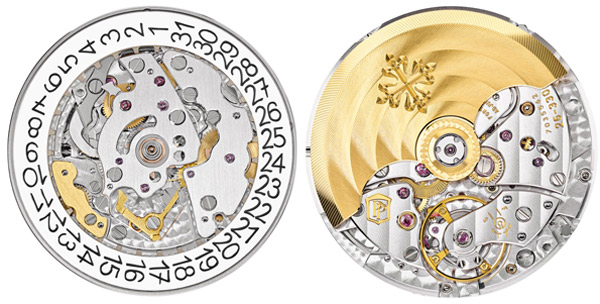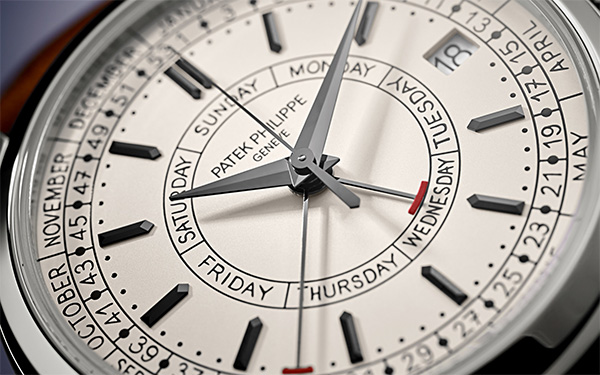Let’s start with a statement that might shock you: I am not a big fan of grand complications. For many fans of fine watchmaking, what I have just said may put you off reading any further. But let me explain why.
First, I admit that these watches are fantastic examples of style and technology, of know-how and imagination and, what’s more, are proof that watchmakers are artists. I have been lucky enough to observe watchmakers working on watches at their workbenches and see the fire in their eyes when they talk about the watches they make.
But, aside from being a watch, a high-end timepiece must also be able to awake sensations and emotions. So you need time to appreciate its importance and its true value.
So why then, after such a declaration of love, can I still write that I am not “touched” by these works of art?
Because I am a firm believer in accessible watches. A watch should remain what it is supposed to be: an everyday object that is simple, useful but nevertheless intimate. And today grand complication watches are too far removed from reality, in terms of both emotions and cost.
First of all, there is the cost. For most people, a grand complication is an inaccessible luxury. It is too expensive, too far beyond economic reality, too extreme. It takes watchmaking to another – too distant – world.
You may well retort that we have hypercars in the automotive world, so why not hyperwatches in the watch world? And you would be right.
But the grand complication watch is even more different from these exceptional cars because it is even more difficult to comprehend. While it is relatively easy to understand Bugatti’s “La Voiture Noire”, it is more difficult to grasp all the nuances of a watch packed with complications.
The other thing that bothers me is the emotional distance. In my humble opinion, the grand complication “destroys” the main role of a watch, while the hypercar “hypertrophies” the notion of a car.
That is the real problem with fine watchmaking: it removes the main vocation of the watch. And that is why I tend to keep my distance from such items. I like watches with modest ambitions that grand complications sometimes seem – unintentionally – to be making ridicule of by affirming too much technical superiority.
But I respect these watches as works of art, as well as the technical and artisanal prowess that has gone into them. And I know that I will never own one of these objects. I can also admit that I have never even held one of these marvels in my hands. For reasons unknown to me, even when I have had the chance, I have always wanted to keep my distance from them.
To keep on the offensive a little, there is something else that sometimes bothers me about these grand complications. They want to do too much, at the risk of doing it badly. Too many functions, too many components, too many extremes.
In wanting to push boundaries, these watches become a technical receptacle that loses its meaning. We can understand the presence of a tourbillon, even if its role nowadays is completely useless. But why have two, or three? Why have it rotating one way rather than the other? And I’m OK with one complication, or maybe two, or even three… but why stack them all on top of each other rather than simplify them?
So don’t try to do too much. Art should remain simple. And so should a watch…
The grand complication watch is an exceptional creation that has lost some of its usefulness at the expense of prestige. Because watches were, in their day, genuinely useful. All of the functions they offered were important: a chronograph to measure short time intervals, a more or less detailed calendar, a moon phase to track tides, time zones for travelling, an alarm, a tourbillon to improve precision and a striking mechanism to tell the time at night. And more besides…
And today?
The need for complication is still there. More than ever, in fact. And that is the huge paradox of grand complications. More and more people are using them. But their name has changed. These new objects are now called smart watches. They are packed with technology and are affordable yet highly complex. They push the limits of miniaturisation and are winning people over. They talk to you, inform you, measure you. Maybe in the future they could even save your life. But are they really watches? I genuinely don’t know, but one thing is certain: they are eating up market share and threatening the market for traditional watches.
To conclude, let’s leave nostalgia aside. Because there are complicated watches that can still awake our enthusiasm, even among the more sceptical. And when I saw this Patek Philippe 5212A for the first time, I dreamed about holding one. Because this Calatrava appeals to me for a number of reasons: it’s simple, uncluttered and emotionally interesting, and it looks like a “normal” watch. And that’s how it seduced me.
Why Patek Philippe ?
I’m going to admit something that might surprise you. I have never been inside the Patek Philippe store in Geneva. Not because I never had the chance. I’ve passed by it hundreds of times and I’ve even stopped to look in the windows. I even visited the Patek Philippe exhibition in New York with my family. But I have never crossed the threshold of the famous store at 41 Rue du Rhône.
I think that in this way I am demonstrating a form of respect for the brand established by a watchmaker who was born in the same country as my father. So it’s difficult for me to say any more about this company, which, as we all know, has made such a huge contribution to the field of watchmaking. Patek Philippe is a reference, a monument and one of the best flag-bearers for Swiss – and Genevan – watchmaking.
Patek Philippe does, of course, offer a number of complications that “scare” me. But it also offers models that fit much better with my personal horological values. It combines gravitas at every level with self-assured classicism. Whether you like it or not, nobody can ignore Patek Philippe and its technical accomplishments.
When it comes to grand complications, Patek Philippe’s workshops are the benchmark. Some of the company’s creations hold records as the world’s most complicated watches, as much as such a record can actually be quantified.
The 6300G is the perfect example of what I mentioned above. Its movement comprises 1,400 components in a case that is just as complex. It is extreme, or even extremist. It’s unrealistic and unattainable. I respect it as much as I fear it, because it does too much.
But that’s not the timepiece I want to talk about today. Instead I have chosen a watch that appeals to me because it is far removed from its highly complicated predecessor. It offers some refreshing characteristics.
The Patek Philippe Calatrava 5212A: What week is it?
The first Calatrava was created in the 1930s by David Penney, who wanted a watch with a simple and understated design. At a time when Patek Philippe was developing grand complications, the Calatrava would become an example of stripping things down and refining them. Its name may well evoke wars – and the Spanish military-religious order of Calatrava – but it is nevertheless a watch that remains discreet and can therefore appeal to the biggest audience.
Since the 1930s, there have been numerous versions of the Calatrava, but with each new one Patek Philippe managed to preserve the refined aesthetics that are so far removed from the overcrowded grand complications.
Now, in 2019, the brand from Geneva presents a new version of the Calatrava, the very surprising 5212A. I like it for a number of reasons. First, its 40mm case is in steel, which is still quite rare for a Patek Philippe. It also keeps the style of the first three-hand models, with a simple round case. Furthermore, by choosing a 40mm case, Patek Philippe has gone for the contemporary option with a diameter aimed for the greatest appeal.

The off-white dial looks simple, until you take a closer look. The combination of steel and this cream colour gives an impression of softness but also gives the watch a real presence on the wrist. The Calatrava 5212A is a seductress and she knows how to surprise. Because with this watch Patek Philippe has introduced a brand-new complication. For the first time, the brand has a watch that can display the week, in addition to the date, the day and the month (and the time, of course!). What is the point of this new complication? To be honest, I don’t know. I don’t even check what week it is on my iPhone, so why would I want to do it on a watch? So the complication itself is not much use, although it is appealing.

It all comes from the way it is incorporated on to the dial and how it fits in with the other elements of the watch. Apart from the date, all the other information is indicated by hands. The magic of the Calatrava 5212A comes from the interplay between the hands and the apparent simplicity of the dial. Even though it comprises a lot of elements, it remains eminently legible thanks to the coherence of its indications. There is no window, there are no subdials and no colour contrasts. The Calatrava remains loyal to its origins.
But it nevertheless has something unusual about it. You need to take a closer look at the dial to see that the font used is unusual, strange even. Patek Philippe chose to reproduce the handwriting of one of the watch’s designers. So it isn’t actually a font at all, just a reproduction of “human” handwriting. I love it! This little detail means that the Calatrava 5212A bridges the gap between technicality and emotion and we have to thank the people at Patek Philippe for daring to incorporate this detail that changes everything.

Because of this typography, the Calatrava 5212A looks imperfect, or even poorly finished. And you know what? That’s probably why we should consider this watch to be a genuine success, not just on a technical level but on a “societal” level, too. With the 5212A Patek Philippe manages to take itself not too seriously but at the same time produce a watch of technical excellence. It is provocative, fun and imperfect. Coming back home after watching Avengers End Game, I couldn’t help but see a little bit of Ironman in this Calatrava.
In conclusion, we have a grand complication that knows how to play down the “grand” and not take itself too seriously by hiding the very same quest for perfection seen in the brand’s other complications.
The Patek Philippe 5212A is a nice surprise that has got me liking grand complications and may even encourage me to enter the store at 41 Rue du Rhône on my next visit to Geneva.
What does the devil’s advocate think?
The devil loves excess, exaggeration and vulgarity. So nothing about this watch could interest him...
But, taking a closer look, there are a couple of details that bother me. First, the strap. I like the simplicity of the gold leather (well done, and thanks for not killing any alligators), but I wish Patek Philippe had kept the buckle with the Calatrava cross.

Second, even if the 40mm case seems to be an ideal choice, one or two millimetres smaller would have brought it even closer to perfection.
Finally, I would have preferred to see the date window in the same colour as the dial.

Apart from that, there is nothing more to say. The Patek Philippe Calatrava is a model of sobriety and balance.
How to wear this Calatrava 5212A?
The Calatrava is a special kind of complication that is best shown off with a simple look. So let’s ignore the brand’s advertisements and go for a white polo – or popover – shirt. This mix between a polo shirt and a shirt fits perfectly with the image of the 5212, refined but simple. The most affordable models are available from Suit Supply, but you can also find them at Proper Cloth or G Inglese, which offers its famous Agnelli polo shirt in a variety of colours.
To keep things simple, try cargo pants from Standards. I like these trousers with pockets on the legs that allow you carry things around without looking too weighed down.
As you know, I love blazers, and for our Calatrava I would opt for denim from John Varvatos. The jacket may seem stiff at first, but it will soften over time to become a second skin.
For the shoes, it has to be a pair of sneakers, this time from JM Le Gazel – with exceptional patina – or Altan, whose Camo model is worth a look.
Now you’re ready to stroll along the shores of Lake Geneva. If you have time, pop into the Patek Philippe store and let me know whether it’s worth a look!




